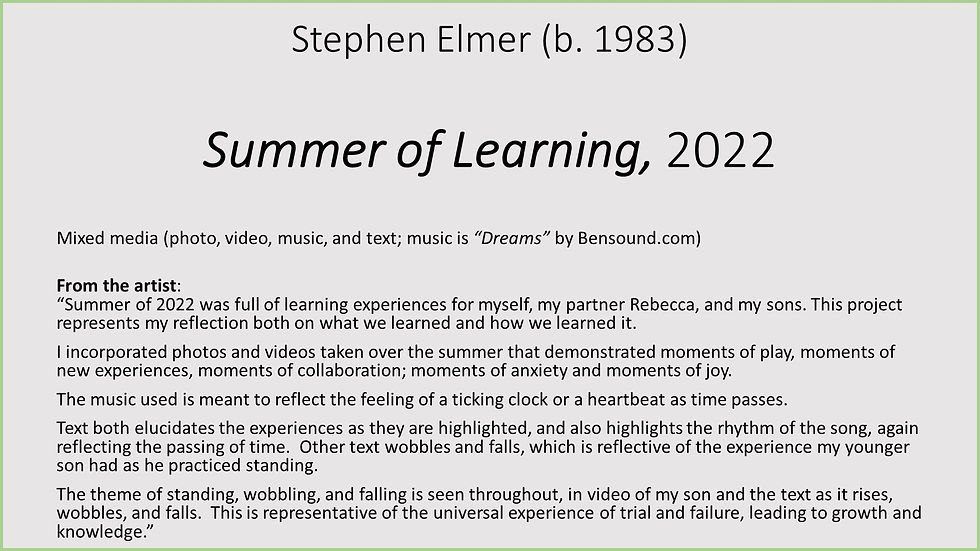Universal Design for Learning and Intersectionality
- elmerst2
- Jul 31, 2022
- 3 min read
I've recently been reading about universal design for learning (UDL) and intersectionality. These two topics highlight my responsibilities toward students in my place of practice.
Universal Design for Learning
The primary goal of UDL is to consider all aspects of the learning process and to employ strategies in curriculum design to allow students with varying interests, motivations, strengths and weaknesses to easily enter into the learning process. It is a framework to help students engage with curriculum and develop planning and self assessment skills to promote future learning and productivity.
As I reflected on UDL, I noted that in much of medical education the primary means of engaging students is to highlight the importance of grades and how they factor into career placement. Students are encouraged to work toward top quintile ranking, which is a way of distinguishing oneself from the “lower” 80% of students in one’s cohort.
Unfortunately, students in the highest rankings do not necessarily demonstrate clinical readiness, patient empathy, or even understanding of applied medicine. Based on a recent survey I conducted with peers in my professional network (click here to view a website I built which includes excerpts of the survey results, as well as my proposed, though as I now view it, incomplete, solution), faculty generally agreed that passing standardized assessments or high grades do not necessarily equate with higher order levels of understanding related to medical learning.
I believe there are several UDL checkpoints that provide concrete guidance towards deeper engagement and improved learning in medical education. First of all, increased focus should be given to appealing to why students are learning about medicine. An appeal to a passing grade in a course or assessment may be enough for many students, especially the most competitive ones. However, for many, the reason for pursuing medical education is a personal concern for others; appealing to the pathos of these students may foster better engagement and make the learning experience feel more “relevant, valuable and authentic,” (CAST, 2018).
Secondly, student understanding may be improved by increasing mastery-oriented feedback. As highlighted above, medical students tend to gauge their understanding of a course's subject-matter based on a comparison of their grade to those of others in their cohort. Rather, students should be provided specific feedback related to how their understanding relates to objective standards, and “emphasizes effort, improvement, and achieving a standard rather than on relative performance,” (CAST, 2018).
Intersectionality
Intersectionality is a term conceived by Kimberlé Crenshaw to describe the compounded vulnerability of black women to racist and sexist aggression, and to highlight the opportunity for blindness by others to these unique vulnerabilities.
This term can be applied to other unique, compounded prejudices as well (it relates to all races and sexual orientations). In the field of medicine, special attention must be paid to these vulnerabilities; recent publications highlight that sexual harassment (Lautenberger et al, 2022) and racism (Serafini et al, 2020) are endemic to the practice of medicine and medical education. How do these injustices compound in unique ways, especially for students in medical education?
I personally must reflect on how I might positively contribute toward promoting equality and respect toward students in my field of practice. One consideration I have is to build out a faculty development workshop which simply highlights correct pronunciation of ethnic names. I believe this basic understanding, put into practice, would have multiple benefits: 1) students would feel seen, known, and respected by having faculty endeavor to pronounce their names accurately; 2) faculty would begin to see students in light of their individualized cultures and backgrounds, and by acknowledging how culture plays a role in the individuation of a student, this may lead to increased alignment of curriculum toward UDL guidelines; 3) students would be inspired to emulate this same level of respect toward their patients as they begin to practice professionally.
These two areas (UDL and intersectionality) must be considered in a complimentary fashion as we educators develop and design curriculum. We must be aware of how every individual approaches their education from a unique perspective, and each of these individuals must grapple with unique challenges. We have a responsibility to acknowledge these challenges and assist as best we can.
References:
CAST (2018). Universal Design for Learning Guidelines version 2.2. http://udlguidelines.cast.org
Lautenberger, D., & Dandar, V. (2022, July 26). Addressing sexual harassment in academic medicine. AAMC. https://www.aamc.org/news-insights/addressing-sexual-harassment-academic-medicine
National Association of Independent Schools (NAIS). (2018, June 22). Kimberlé Crenshaw: What is intersectionality? [Video]. YouTube. https://www.youtube.com/watch?v=ViDtnfQ9FHc
Serafini K, Coyer C, Brown Speights J, et al. 2020. Racism as experienced by physicians of color in the health care setting. Fam Med. 2020;52(4):282-287. https://doi.org/10.22454/FamMed.2020.384384





Comments